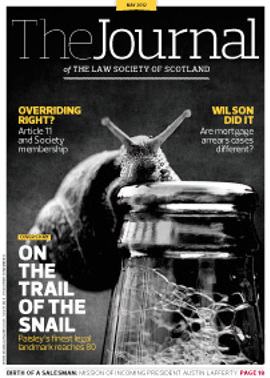Looking into the past

Lord Tyre’s recent decision in B v B [2012] CSOH 21 (3 February 2012) is interesting in relation to the sometimes unpredictable issue of unequal division of matrimonial property.
Parties married in 2000 and separated in 2010, though remained resident in the same property. The defender wife had a son from a previous relationship and there were two daughters of the marriage, care of whom was agreed.
The pursuer husband produced a schedule listing his personal and business assets, prepared by his accountant prior to the marriage, including pre-marriage valuations. The existence of this “DIY pre-nup” had been unknown to the defender.
Process of conversion
The pursuer attempted to trace the application of funds stemming from his pre-matrimonial property through the marriage, and to identify where pre- marital assets had been converted into matrimonial property. It was argued that he had provided initial capital to fund the purchase of houses developed and sold on during the marriage and the eventual profits were now represented within the matrimonial property, constituting special circumstances justifying an unequal sharing. A “ransom strip” of land purchased during the marriage next to land he owned pre-marriage derived its value from the latter asset and should be left out of account altogether. A Halifax pension, which was wholly matrimonial property, stemmed from three separate pension policies, contributed to at different times before and during the marriage. A sum equivalent to the proceeds of an investment policy he surrendered in 2001 should be allocated to him; and personalised registration plates bought with the parties’ daughters’ initials should be retained by him to be gifted in due course.
For the defender, it was argued that the only compelling reason to depart from the presumption of equal sharing was apportioning the value of the pursuer’s pension to take into account the pre-marriage period of membership. The bulk of the matrimonial assets had no direct link back to pre-matrimonial assets justifying an unequal split. The pursuer had failed to establish any clear audit trail linking the proceeds of house development undertaken during the marriage to his pre-matrimonial assets. The business assets were now entirely different to those held pre-marriage and their present value was attributable to the pursuer’s efforts during the marriage. If special circumstances were found to exist, the defender would have suffered an economic disadvantage in the interests of the family, through reduced income and pension interests due to part-time working.
Both parties sought transfer of the matrimonial home into their sole name.
In and out of the pool
Lord Tyre concluded that the source of funds used to acquire matrimonial property justified an unequal sharing in favour of the pursuer. However it would not be appropriate to attempt to restore the whole value of the assets he brought to the marriage. The marriage was not particularly short and had been characterised by the parties’ joint efforts to earn a living and to provide and maintain a family home.
He considered that it would be a fair approach to allocate a sum to the pursuer broadly representing certain pre-matrimonial assets which had effectively remained outwith the “pool of common wealth of the family” throughout the marriage. Those assets were identified as the ransom strip, some limited element of the capital invested in house development, and a portion of the pursuer’s pension. He accepted expert evidence that the fairest method of apportioning the pension was by reference to the time of payment of contributions, rather than to periods of membership. The case fell outwith the scope of the 2000 Pension Regulations.
The remainder of the matrimonial property fell to be divided equally between the parties.
Interestingly, this division brought about a percentage split of 61-39% in the pursuer’s favour, which Lord Tyre rounded to a 60-40% split in order to achieve what he regarded as fair sharing. This division ensured that the matrimonial home required to be transferred to the pursuer, with a balancing capital payment. The economic disadvantage argument for the defender was rejected, but an order for six instalments of capital payment totalling £14,000 over three years was made in lieu of her claim for periodical allowance.
This decision is interesting insofar as the outcome, a 60-40% split of the matrimonial property, is within what could be seen as the usual parameters of an award, in circumstances where the pursuer sought an outcome which broadly restored to him all his pre-marriage assets.
Marriage is a joint enterprise, a contract with important legal and financial consequences which cannot be ignored. Even where special circumstances are found to exist, the court is not obliged to depart from equal sharing, as set out as long ago as Jacques v Jacques 1997 SC(HL) 20. The starting point for a fair sharing of matrimonial property is equal sharing, and any departure from that must be justified.
In this issue
- Arguments in store
- Farming the constitution
- Willing to wound, yet afraid to strike?
- Deferred consideration – worth the paper?
- OSCR: the secondees' perspective
- To efficiency and beyond
- Reading for pleasure
- Opinion column: Fraser Tait
- Council profile
- Book reviews
- President's column
- Wind farms: a challenge to registration
- Snail of the century
- Rights both ways
- Sell, sell, sell
- RBS v Wilson: light in the tunnel?
- Take the heat out
- Prepare for case management
- Looking into the past
- Migrant days numbered
- CPI - the story so far
- Brighton declares
- Mary Mary quite contrary?
- How to avoid that Guarantee Fund interview, and worse...
- Law reform roundup
- Apportionment of price for SDLT
- Business checklist
- Practical guide to legal risks
- Ask Ash






